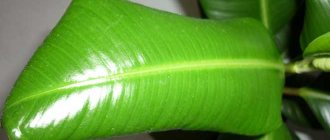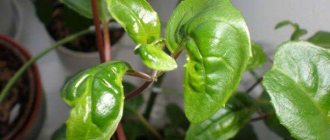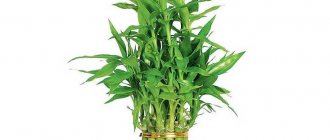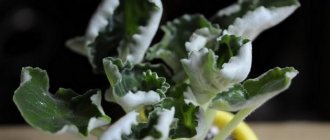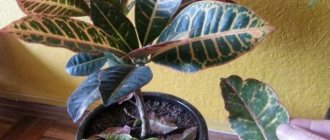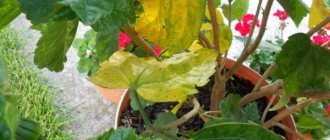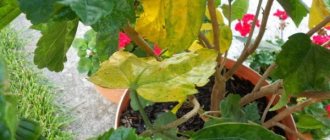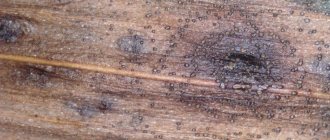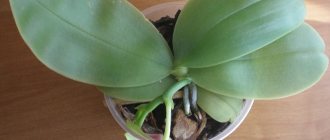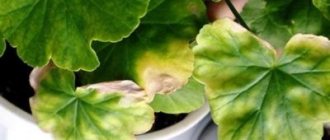Every gardener has sooner or later encountered the problem of leaf curling. Perhaps the agricultural technology was chosen incorrectly or suitable conditions for the plant were not created. Another reason could be insect pests, after which the leaves turn into a tube. In order to solve the problem, it is necessary to find out where and why it arose, that is, the reasons that the leaves curled.
Each plant may have its own independent, individual reason for this problem. For example, myrtle leaves dry and curl when the flower is too hot. However, there are a number of characteristics that can be attributed to all types of vegetation.
No. 1 Physiological causes of leaf deformation
Curled leaves of indoor hibiscus
For its growth and development, any plant requires the presence in the environment of various nutritional compounds, as well as substances critically necessary for maintaining vital functions. In particular, the plant needs amino acids to form tissues. Plants obtain oxygen and hydrogen from air and water, nitrogen from the soil, and carbon necessary for the production of sugars (as a result of photosynthesis) from carbon dioxide present in the atmosphere.
Theoretically, this is enough for normal growth, but that’s not all. To control the processes occurring in tissues, special microelements are also needed. Their concentration is very small in comparison with the substances already mentioned, but without their presence the plant will die.
Liquid complex fertilizer is used
Such substances include:
- magnesium, which is necessary for the formation of chlorophyll molecules;
- iron, which acts as a catalyst for photosynthesis;
- potassium (promotes the accumulation of sugars and prevents them from breaking down quickly);
- boron, necessary for the formation of plant germ cells;
- phosphorus, which serves to speed up metabolic processes;
- etc.
These are only the main components necessary for the normal functioning of the plant body. About a third of the periodic table is somehow involved in regulating their growth and reproduction processes. Naturally, a lack of certain substances leads to disruptions in the normal life of the plant.
It is also important to understand that not only a deficiency, but also an excess of some components can cause leaves to curl. For example, excessive doses of potassium fertilizers can sometimes have the completely opposite effect.
Curled leaves on young tomatoes with an excess of potassium fertilizers
As a result of research, it was found that leaf curling in young plants is associated with a lack of molybdenum, boron, magnesium and copper. In older adults, there is a deficiency of potassium, magnesium and fluoride.
Another reason may be the presence of substances in the soil or air that are frankly harmful to plants. Thus, chlorine, in almost any form, is dangerous for plants, since, being an element of group 7, it reacts with almost all components and accumulates in plants in large quantities. This leads to metabolic disorders and is the cause of many diseases of ornamental crops.
Curled leaves on indoor Saintpaulias
But it is not only the absence or excess of certain mineral “building blocks” that leads to such results. The influence of external factors plays an important role. For example, a sudden change in temperature, light or humidity caused by drafts, cold watering, shading, etc. can lead to disruption of the normal rhythms of plant life and cause deformation of its leaves and stems.
Next, we will consider the most common causes that cause changes in the shape of leaves and describe methods on how to eliminate their unpleasant consequences.
The fertilizer was chosen incorrectly
If you constantly use the same fertilizer, the plant exceeds its tolerance and thereby ceases to receive useful microelements or they are simply not included in the preparation. This problem is clearly expressed in balsam; its leaves dry out and curl just 3 months after applying the same preparation. It is necessary to constantly alternate fertilizer preparations, using organic and mineral ones. Plants are mainly deficient in molybdenum, copper, magnesium, boron and zinc. But there are also species that contain potassium in large quantities and this causes the leaves to curl. When applying fertilizer, use it only according to the instructions.
No. 2 Mistakes when watering
Curled dendrobium leaves due to insufficient watering
There are relatively few errors as such when watering. These include:
- violation of the watering regime;
- use of water of unsuitable quality;
- watering at the wrong temperature.
The most common reason, naturally, is the first. Leaves may curl due to excess moisture in the soil. This is especially noticeable for drought-resistant crops. At the same time, the leaves of moisture-loving plants will wither if there is a lack of moisture.
Solving this problem is quite simple - you need to adjust the watering regime. The only thing to remember is that this needs to be done gradually so as not to expose your pet to additional stress.
For drought-resistant crops, moderate or heavy watering followed by loosening the soil is recommended. It is recommended to water moisture-loving crops with a small amount of water, but do this constantly. A good solution would be to use wick irrigation or mulch the soil with material appropriate for a particular plant.
Urea (carbamide) is one of the preparations for feeding
An additional measure, carried out simultaneously with the normalization of plant watering, can be the application of foliar fertilizing with urea. To do this, spray the leaves of the plant once with a solution of urea in water (1 tablespoon per 5 liters of water). 2-3 days after fertilizing, it is recommended to spray the leaves with a 0.3% solution of potassium permanganate.
Another common mistake when watering, which leads to plants curling into tubes, is the use of unsettled tap water. It contains too high a concentration of fluorine and chlorine compounds, which, as already mentioned, are extremely harmful to plants. Everything here is relatively simple: the water should be allowed to settle for several days before watering.
Using too cold or too warm water when watering is also undesirable, since root hairs are very sensitive to its temperature. In the most unfortunate cases, they may temporarily lose their abilities, and the plant will be deprived of soil nutrition for several days. This can have critical consequences, since the curling of the leaves will be followed by their withering and death of the plant.
For irrigation, you should use water with a temperature 2-3 degrees warmer than the air temperature in the room.
Lack of moisture
Lack of moisture can be detrimental to any plant. This is the most common cause of curled leaves. At the first signs of a lack of moisture, the plant begins to compensate for this by not supplying moisture to the very top, to the crown. This is how the upper leaves begin to experience a deficiency, they gradually fade and curl. And after some time they fall off.
If the plant continues to feel a lack of moisture, then the drying process will gradually move from the crown down to the roots of the plant. To correct this, it is necessary to water abundantly. For powerful bushes, it is necessary to saturate the soil to a depth of 50 cm. Having drunk, the plant will begin to restore its strength and after some time will again acquire fresh greenery.
No. 3 Incorrect feeding
Deformation of cyclamen leaves due to improper feeding
The existing opinion that indoor plants can be fed with the same substances or compounds as garden (or vegetable) crops is only partly true.
Plants located outdoors have much more opportunities to receive nutrition from the environment than indoor plants, if only because the size of their root system is practically unlimited. And most importantly, this root system has at its disposal a much larger area of land, containing almost all the necessary microelements at different levels.
An example of leaf curling in petunia seedlings
Therefore, for them, only the presence of basic substances that go into the direct formation of the vegetative part and fruits (nitrogen, potassium, magnesium) is critical. And almost all the substances that regulate their vital functions are present in relative abundance. Indoor plants with a limited volume of soil are deprived of this opportunity.
Most often, the leaves of indoor flowers curl due to a lack of substances such as molybdenum, manganese, sulfur, boron and iron. The problem can be solved very simply - use specialized fertilizers for indoor plants, containing the entire necessary range of nutrients.
Another problem associated with fertilizing that leads to leaf curling is an overdose of potassium and nitrogen in indoor plants. These substances have the ability to accumulate in plant tissues and react with various compounds, thereby disrupting metabolism and the processes of formation of new cells. Therefore, gardeners should always follow the norms for applying certain products.
Complex fertilizer for flowers
It is recommended that when using specialized complex fertilizers for ornamental crops for the first time, they are applied in a concentration half the recommended amount in order to see how the plant will respond to fertilizing. If everything goes well, the norm is applied in full.
Why do the leaves of indoor flowers and seedlings curl?
Houseplants that stand on the windowsill, as well as seedlings grown there, often experience thermal shock. The reason is the large difference in temperature in the room and at the window: in winter the glass is cold, and in summer it is strongly heated by the sun's rays.
In addition, dry air is often the cause of leaf deformation.
What to do?
Move the plant as far away from the window glass as possible to prevent the leaves from touching it. If flowers and seedlings look drooping, spray them with a solution of Zircon or Epin-Extra.
To increase air humidity, during the heating season, cover the radiators with a wet towel, and spray plant leaves daily with clean and settled water at room temperature. If you have enough space on the windowsill, place a container of cold water between the flower pots.
No. 4 Diseases and pests
Change in the shape of cucumber leaves when affected by spider mites
Plants are the basis of any food chain, so it should not be surprising that they will always attract other living organisms that want to use the resources they have accumulated.
Fungal diseases are the most common cause of leaf curl. This is most pronounced in the case of damage to the following diseases:
- powdery mildew;
- cytosporosis;
- white and gray rot;
- rust;
- spotting.
Moreover, curling often acts as an additional symptom of the fungus, appearing both before and after the main ones (spots, dots, yellow or brown formations, etc.)
The fight against fungal diseases is standard: the use of various fungicides suitable for a particular type of plant. For those who do not want to purchase any special preparations, there is a standard processing procedure using a universal remedy - Bordeaux mixture.
Bordeaux mixture
It is used in a concentration of 1%, often used together with a soap solution (30 g of vitriol and 200 g of soap are diluted in 10 liters of water). Affected plants are sprayed in the evening or in cloudy weather. Treatments are carried out every 3-4 days until symptoms disappear completely. The use of other fungicides, for example, copper oxychloride, is also allowed. It is used in lower concentrations (from 0.3% to 0.5%).
Another problem associated with diseases is viral infections. Most often they are caused by the tobacco mosaic virus or wilting virus. Their symptoms may be different, but in general they have approximately the same appearance: the leaves first turn yellow in several places, then curl, dry out and fall off. Unfortunately, there are no funds available here.
You can try to remove the affected plant fragments, and if the virus has not had time to spread further, perhaps the plant will be saved from the disease. But, in the vast majority of cases, viral infections are fatal for plants. Therefore, it is imperative to completely destroy the affected specimen to avoid further spread of the virus.
Whitefly
There are also many pests that cause leaf curl. Mainly, these are insects that feed on plant sap.
Their most typical representatives can be:
- spider mite;
- leaf roller caterpillars;
- whiteflies;
- thrips;
- aphid;
- scale insects;
- pennies and their larvae.
Most of the pests listed are either mites or insects that have strong immunity, so the use of conventional insecticides may be ineffective. Therefore, it is recommended to use stronger agents - acaricides (special agents against ticks) or the latest generation insecticides.
Among chemical agents, the use of Actellik, Aktara or Fitoverma is recommended. Lovers of natural remedies can use a decoction of wormwood with a soap solution (150 g of wormwood and 20 g of soap are diluted in 5 liters of water), infusions of celandine or garlic.
Chemical treatments should be carried out in strict accordance with the instructions; folk remedies are used at intervals of several days until the pests completely disappear.
Spider mite
For preventive purposes, plants can be treated with the same drugs, but in smaller doses; however, this should only be done if plants are attacked by pests from year to year.
#5 Environmental influence
Often, leaf curling occurs due to other reasons, primarily related to improper plant maintenance or its sudden change (for example, bringing plants out of dormancy too quickly)
Here we should consider the influence of each factor separately.
Illumination
Curled leaves and burns on mature tomato seedlings
Most plants like to be planted in sunny areas. This is not surprising, since to obtain nutrients (sugars) you need not only carbon dioxide and water, but also light radiation.
On the other hand, there are crops that do not like too much light, since a small amount of light is enough for them, and excessive doses can cause burns to the integumentary tissue.
It is necessary to carefully study the conditions of keeping a particular culture so as not to make a mistake with the degree of its illumination and follow them exactly. Sometimes illumination is seasonal; for example, some crops are generally recommended to retreat to dark rooms during the dormant period.
In addition, direct sunlight is often harmful to plants, but the illumination should be good and last several hours a day. In this case, various methods of dispersion are used, using, for example, gauze or a mesh that is hung on the window.
Temperature
Pepper leaves curling due to high temperature
This is a very important parameter for any crop, often more significant than illumination. Moreover, it should be remembered that the range of comfortable temperatures has upper and lower limits.
Sometimes excessively high temperatures can be even more dangerous than too low temperatures. This is due to the fact that at high temperatures, the processes of evaporation of moisture from the leaves are accelerated, which can lead to their rapid withering and death of the entire plant.
Often leaves curl in winter because they touch cold glass or are exposed to drafts. In this case, it is recommended to move the pot away from a potentially dangerous place.
Air humidity
Curling and falling of dracaena leaves due to excessive humidity
Each crop has its own limits for changing humidity levels. Desert plants prefer dry air (with humidity no more than 30-40%), forest or swamp crops may require fairly high values of this parameter.
In any case, it should be controlled to avoid leaf curl. Some gardeners are trying to solve the problem by sprinkling plants using a spray bottle. This method is not very effective, since it provides an acceptable level of humidity within a few tens of minutes.
It is recommended to either use stationary humidifiers or move the plants to a more humid room. For example, in the kitchen or bathroom the humidity is on average 20-30% higher than in the bedroom.
Plants should not be placed near oil heaters or steam heating radiators. These devices “dry” the air very well, reducing its humidity to too low values.
Soil acidity
Often leaf curling occurs against the background of chlorosis, which is caused by soil acidity that is unsuitable for a given plant.
The digestibility of elements critical for the plant depends on the acidity level of the soil. If it is too acidic, or, conversely, too alkaline, many elements will be poorly absorbed by the plant, and even fertilizing will not improve the situation.
For example, on acidic soils, plants are practically deprived of potassium, calcium, magnesium and sulfur. Too alkaline soils make iron, manganese and zinc unavailable to plants. Deprived of these essential elements for life, plants begin to wither and their leaves curl.
The acidity level of the soil should be regularly checked and, if necessary, deoxidation or alkalization operations should be carried out. Typically, various mineral or organic fertilizers are used for this purpose.
For most plants, an acceptable pH level is between 6.0 and 7.0. But there are exceptions, so for each crop you should know the acceptable limits of this parameter and constantly monitor the condition of the soil.
Plant adaptability
We, who live in very cold climates, think that only sub-zero temperatures can kill indoor species. This is not so: for spathiphyllum +5°C is already frost, and for pelargonium and chlorophytum this temperature is the lower limit of endurance.
Dying spathiphyllum. Photo from maxpull-tlu7l6lqiu.stackpathdns.com
But these abilities are not limitless, because plants came to our homes from places with very different climates. Sometimes they feel good all year round, but in the fall, when the heating is turned on in the houses and the rather humid autumn air in the rooms becomes dry, they suffer (sometimes they even shed their leaves).
The ability of plants to adapt to conditions is not unlimited.
If you provide each indoor plant with optimal living conditions (lighting, temperature, air humidity, proper watering and fertilizing), then problems either will not arise at all, or it will be easier to determine their cause.
The most typical causes of leaf deformation in different crops
Rolling potato leaves
The information provided earlier is too general. Moreover, this is true not only for house plants, but also for those growing in the garden, vegetable garden or greenhouses. The causes of leaf curling due to nutritional disturbances are equally characteristic of trees or shrubs, as well as seedlings.
Each crop has its own specific agricultural technology and, naturally, the reasons for the appearance of curled leaves will also be individual. For example, in cucumber seedlings this can be explained by a lack of moisture, and in some shrubby form of lilac - by excessive pruning. Below is a description of these reasons for some popular crops.
Violets
Violets
Violets The most common reason why violet leaves curl and fall off is improper watering. Moreover, the signs of excess and lack of moisture have approximately the same manifestation: the edges of the leaves curl up and the disappearance of swellings characteristic of violets is observed on the plates. In addition, the veins on the upper part of the leaf blade become very visible on them, which is practically not observed in healthy plants.
If the leaves and stems curl at the same time, this is a sure sign that the flower is infected with mite parasites. It is relatively difficult to notice, for example, a cyclamen mite - you need to carefully examine the undersides of the leaves.
Sometimes violet leaves curl from excess nitrogen fertilizers. This happens when, instead of specialized fertilizers, a mixture of nitrate and potassium fertilizers is used. In this case, the doses should be adjusted or such feedings should be abandoned altogether.
Begonias
Begonia
Begonias The main reason why begonia leaves curl is poor nutrition. The plant does not tolerate potassium deficiency and excess nitrogen. The second most common cause of the phenomenon is improper watering.
In the warm season, begonia needs to be watered daily, during dormancy - once a week. Diseases that have such consequences include powdery mildew and gray rot. In addition, insufficient looseness of the soil can lead to curling of begonia leaves.
Roses
Roses
Roses Rose leaves curl mainly due to improper temperature conditions and lack of moisture. In hot weather, it is recommended to water more often, loosen and mulch the soil. Bushes of many varieties need to avoid direct sunlight, so in hot weather at midday it is recommended to shade them.
Often curled leaves on roses are the result of sap-sucking insects, in particular aphids and mites. It will be useful to inspect the bushes daily to identify parasites and apply the necessary measures in a timely manner. Treatment often comes down to spraying the bushes with a simple soap solution.
Peonies
Peonies
Peonies Curled leaves on your peonies are most often the result of insect activity. In particular, bronze beetles love to eat the leaves and buds of the plant, aphids love to suck out its juices, and the ants that breed them can be carriers of bacterial and viral infections.
The influence of other factors on the deformation of foliage in peonies is much less, since the plant, due to its developed roots, can be cultivated on almost any soil and is not too demanding on fertilizing.
Ficus
Ficus
Ficus The curling of ficus leaves into a boat occurs mainly due to improper watering, in particular when using tap water. The chlorine contained in it leads to burns, which causes curling.
Overwatering when watering is no less dangerous for the plant. This leads to root rot, which can also cause deformed foliage. It is quite problematic to quickly dry ficus soil, therefore, if the plant has been overwatered, it is recommended to urgently replant it into a new substrate.
Too low humidity and lack of watering lead to the fact that ficus leaves begin to curl at the edges. In this case, it is necessary to water the plants on time and move it to a room with more humidity. Or at least move it away from heating devices.
Rhododendrons
Rhododendrons
Rhododendrons The main reason why rhododendron leaves curl is natural - this is how plants react to cold weather. Moreover, this phenomenon is characteristic of both deciduous crops grown indoors and evergreens grown outdoors.
In the spring, you just need to water the bushes and sprinkle the leaves (of course, those that are not in the Sun), and they will return to normal.
Blueberry
Blueberry
Blueberries are one of the most difficult crops to grow, so the issues of caring for them and diagnosing their condition will have many nuances.
When cultivating this plant, it should be remembered that despite the obligatory presence of acidic soil (pH from 3.5 to 4.0), it urgently needs calcium. With its deficiency, blueberry leaves curl, after which the edges turn yellow, blacken and dry out. Sometimes such manifestations can be seen spreading up the shoots of the plant.
To solve the problem, simply feed the plants with calcium salts. In this case, it is recommended to use not chalk or ash, but calcium phosphate, into the solution of which a little vinegar is added (1 kg of double superphosphate is poured into 5 liters of hot water and 200 ml of 9% table vinegar is added).
Such a mixture practically does not react with the soil and does not change its acidity. In this case, diseased and damaged leaves should be removed.
Hydrangea
Hydrangea
Hydrangea The most common cause of leaf curling in hydrangeas is insects (aphids, mites, cicadas, etc.). Usually, they are treated with some kind of insecticide.
Conventional insect control products will help in resolving the issue - Karbofos, Enzhio, Coragen, etc.
It is not recommended to use too active substances, since the plant can also react to them in a similar way. The same can be said about the use of herbicides on the site to control weeds - there should be no such soil treatments near the hydrangea.
Gloxinia
Gloxinia
Gloxinia Gloxinia leaves curl from attack by parasitic insects (most often cyclamen mites or thrips), or due to errors in care. The main reason is incorrect temperature conditions. The plant must be kept in fairly strict conditions: temperatures from 18°C to 25°C without significant temperature fluctuations during the day.
The same applies to lighting. The plant is recommended to stay in light for 8 hours. It is not recommended to use direct sunlight. They cause burns to the leaf blades, as a result of which they not only curl, but also lose their green color.
Asters
Asters
Asters Asters most often have leaves that curl as a result of fungal infections, in particular fusarium. The following measures are recommended as prevention:
- do not plant asters close to each other;
- apply fertilizers (compost, humus, etc.) in the fall, not in the spring;
- treat plant seeds with foundationazole before planting;
- alternate planting sites for asters in the garden at least once every 5 years.
In addition, the plant's leaves may curl due to excessive watering.
Agricultural crops (tomato, pepper, eggplant, cucumber, potato)
Agricultural crops
Agricultural crops Various garden plants also suffer from the problems described above. In order to grow healthy plants with high yields, gardeners need to know all the intricacies of the agricultural technology of these crops.
In most cases, the causes of leaf curl are similar in the same families, but in some cases there may be differences even in closely related varieties. Sometimes even different varieties react differently to certain destabilizing factors.
For example, when growing tomato seedlings, you should not overwater young plants or expose them to direct sunlight. In adult seedlings, the leaves often curl due to a fungal infection that the plant “picked up” either during picking, or even at the planting stage.
When growing tomatoes, it is correct to regularly feed the plant with at least wood ash in order to provide the bush with the necessary minerals for flowering. Watering should be sufficient and carried out in the evening. If you do it in the morning, the leaves may curl due to an increase in air humidity around the plant under the influence of sunlight.
Insecticide “Aktellik”
When growing cucumber seedlings, special attention should be paid to watering. Moreover, this applies to all components of this process: intensity, frequency, time of implementation, termination in case of prevention and treatment of the plant, etc. It is necessary to water cucumbers daily, in the evening, avoiding moisture getting on the flowers. Features of playing Pin Up Casino for real money Initially, I would like to notify the player that the range of Live games is extensive. Therefore, the most popular slot machines are at the beginning of the list. It has become easier to receive a profitable casino bonus, get a Pin Up casino promo code and activate it on the website. But maybe you should think about spending this winnings on something else? Most Novomatic slots are not progressive, but there are a few slots that offer progressive jackpots. The atmosphere is as if you are in a real casino.
When growing potatoes, the main reason for leaf curling will be pest attacks. The Colorado potato beetle and its larvae, wireworms, potato flea beetles and other insects can significantly damage the roots, stems, tubers and leaves of the plant.
In addition, many of them are carriers of viruses and bacteria that can infect more than one plant. Potatoes require regular treatment against pests, and the choice of products currently does not pose a particular problem - more than 80% of existing insecticide preparations found on the market are recommended for use primarily on potatoes.
Thematic video:
Signs of elemental deficiency in plants / Why leaves curl, wither, turn yellow and die
Why do plant leaves curl? | TOP 5 Main reasons
What to do?
The first step is to adjust the conditions for keeping tomatoes, and only then move on to fertilizing and processing. But keep in mind that curled leaves may not straighten out anyway, but young ones will grow healthy.
Treatment against diseases and pests
Even before planting, treat the seeds with special fungicides and do not forget about preventive spraying. If fungus is detected, choose specialized preparations for tomatoes or vegetables. If the seedlings are infected by a virus or bacterial cancer, the damaged plants must be removed as quickly as possible.
Pests will have to be dealt with comprehensively, because scheduled spraying is not enough. Place traps for butterflies and use special biological products against larvae and clutches. If pests have already been detected, several treatments will be needed at intervals of 3 to 10 days.
Photo: vivien.ge
What to feed
First of all, tomatoes need nitrogen, a deficiency of which the plant, in principle, cannot grow healthy green mass. If the leaves curl up and turn brown at the edges, the tomatoes are lacking potassium.
If they curl up and look burgundy or purple, it’s time to use superphosphates. And when the leaves curl up, but the spots are yellow and blurry, then it’s time to add copper!
Photo: poradum.com.ua
Did you like the post? Subscribe to our channel in Yandex.Zen, it really helps us in our development!

